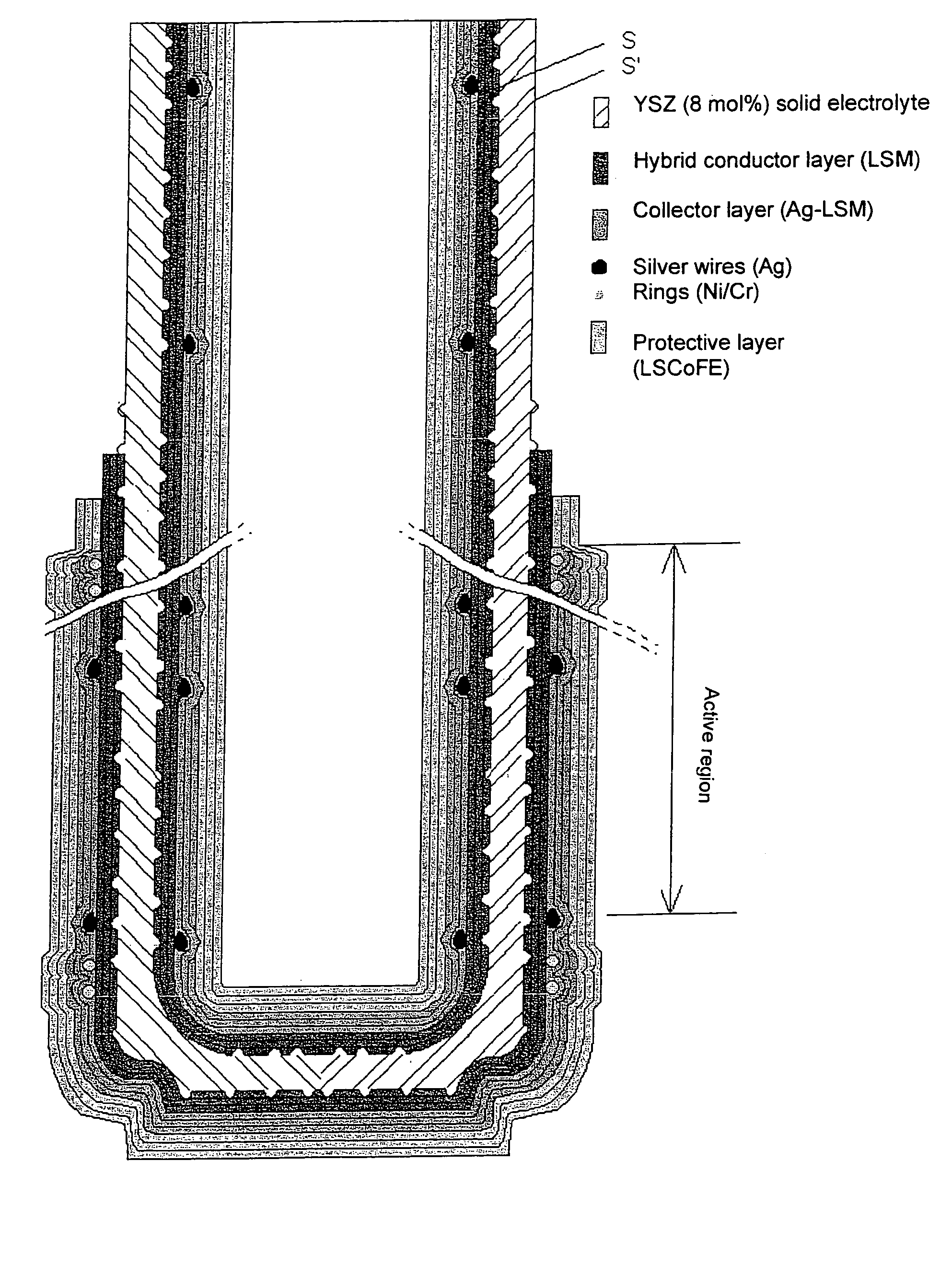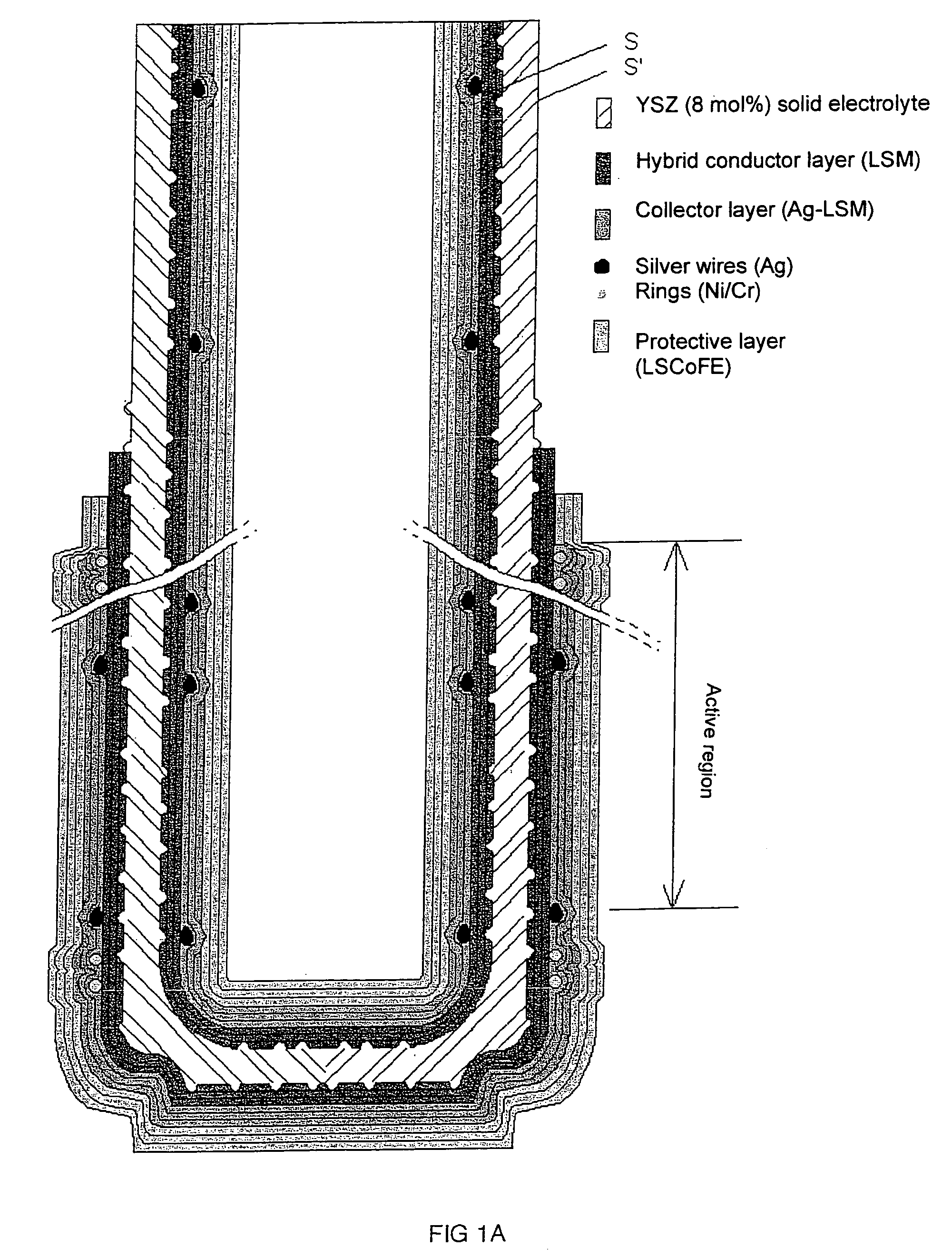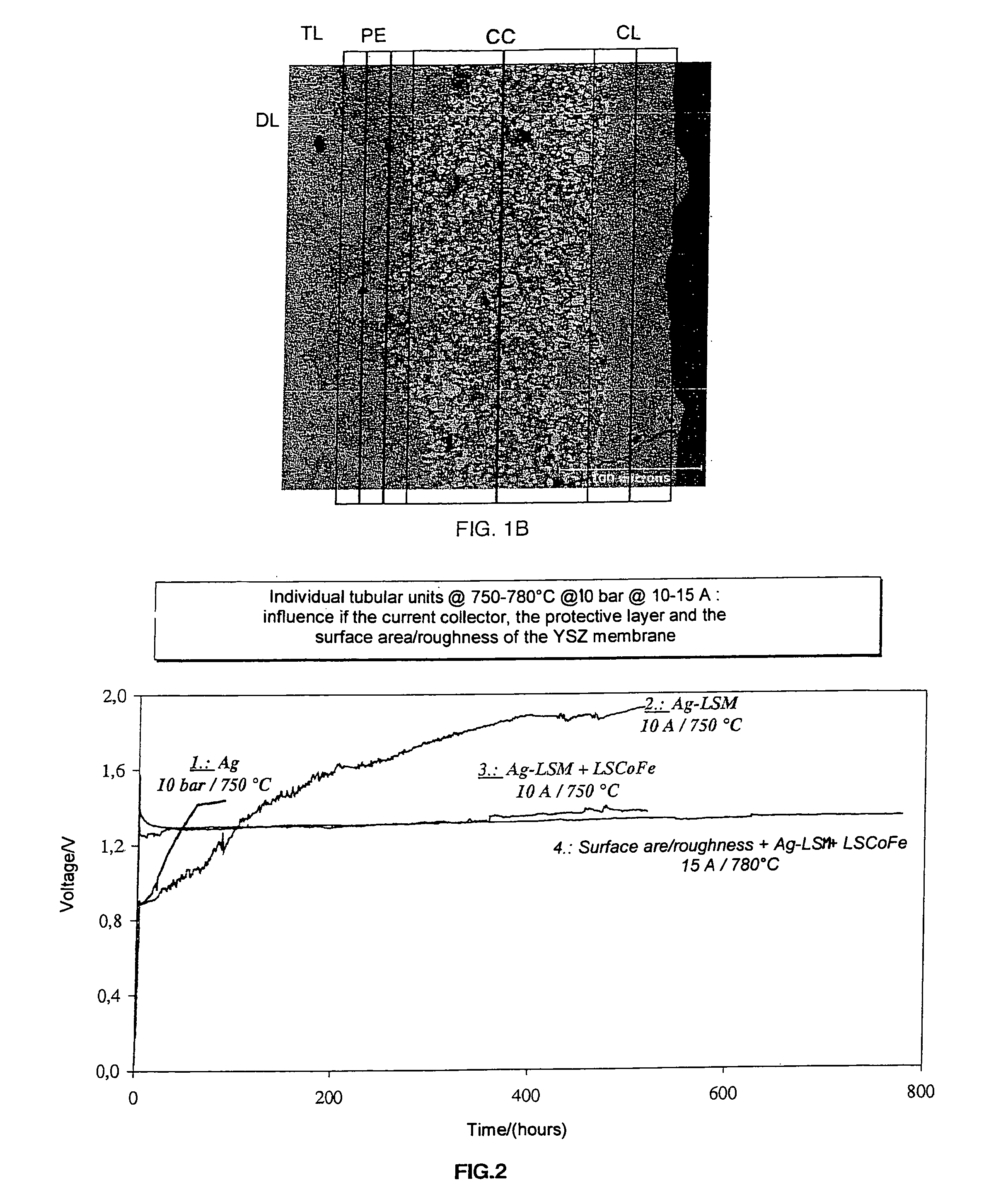Oxide ion conductive ceramic membrane stacked microstructures; use for separating oxygen from air
a technology of stacked microstructures and ceramic membranes, which is applied in the direction of electrolysis components, electrical equipment, electrochemical generators, etc., can solve the problems of poor hybrid conductivity properties of lacoosub>3 /sub>perovskite, etc., and achieves better “bonding” and “volumewise increase” the effect of improving the electrochemical performance of the cell
- Summary
- Abstract
- Description
- Claims
- Application Information
AI Technical Summary
Benefits of technology
Problems solved by technology
Method used
Image
Examples
example 1
Influence of the Architecture and Structure / Microstructure of YSZ (8 mol %) Ceramic Cells / Operating Parameters—Temperature: 750-780° C.; Pressure (Internal Oxygen Pressure): 10×105 Pa (10 Bar): Current: 10-15 A
[0115]Several tubular electrochemical cells (Cell 1 to Cell 4) were prepared, these consisting of:[0116]a solid electrolyte made of yttrium-stabilized zirconia [(8%)YSZ] of 350 mm length, 68 cm2 active surface area and 9 mm inside diameter;[0117]two electrodes made of strontium-doped lanthanum manganite (LSM: La0.9Sr0.1MnOx) of 15 to 30 μm thickness and 30 to 50% porosity;[0118]two current collectors of various compositions:[0119]silver lacquer (thickness: 100-120 μm, low porosity) (Cell 1) or[0120]Ag-LSM (50 / 50 by volume) cermet (thickness: 100-120 μm; porosity between 30 and 50%) (Cell 2, Cell 3, Cell 4); and, optionally[0121]a protective layer on each of the faces of the LSCoFe (La0.8Sr0.2Co0.8Fe0.2Ow) membrane (Cell 3, Cell 4) (thickness: 50-90 μm, porosity: 20-70%) (depos...
example 2
Influence of the Microstructures of the Various Coatings Deposited on YSZ (8 mol %) Ceramic Cells with Specific Surface Area / Roughness. Operating Parameters: Temperature: 780-800° C.; Pressure (Internal Oxygen Pressure): 10×105 Pa (10 Bar); Current: 10-15-17 A
[0138]Several tubular electrochemical cells (Cell 5 to Cell 7) were prepared, these consisting of:[0139]a solid electrolyte made of yttrium-stabilized zirconia [YSZ(8%)] having a length of 350 mm, an active area of 68 cm2 and an inside diameter of 9 mm, and exhibiting specific surface area / roughness on both surfaces of the YSZ solid electrolyte and of the same nature, and with a roughness R and R′ of between 10 μm and 100 μm;[0140]two electrodes made of strontium-doped lanthanum manganite (LSM: La0.9Sr0.1MnOx) with a thickness of 15 to 30 μm and a porosity of 30 to 50%;[0141]two current collectors made of an Ag-LSM (50 / 50 by volume) cermet;
[0142]thickness: 60 to 80 μm (Cell 5, Cell 7) and 120 to 130 μm (Cell 6); porosity: betwe...
example 3
Module of Ten YSZ (8 mol %) Ceramic Cells Having a Specific Surface Area / Roughness and an LSM(15-30 μm) / Ag-LSM (60-80 μm) / LSCoFe (30-40 μm) Structure / Microstructure. Operating Parameters: Temperature: 780-800° C.: Pressure (Internal Oxygen Pressure): 10×105 Pa (10 Bar); Current: 10-15-17 A
[0156]A tubular electrochemical cell identical to that of Example 2, cell 5 in terms of solid electrolyte+“tie” layer, LSM electrode, Ag-LSM cermet current collector and LSCoFe protective layer was used. The system was completely symmetrical.
[0157]The basic electrochemical tubular cell constituting the module of ten units consisted of:[0158]a YSZ(8%) solid electrolyte having a length of 350 mm, an active area of 68 cm2 and an inside diameter of 7.5 mm, possessing, internally and externally, a “tie” surface (development of specific surface area / roughness) with a thickness of between 10 and 100 μm;[0159]two electrodes made of strontium-doped lanthanum manganite (LSM: La0.9Sr0.1MnOx) (thicknesses: 15-...
PUM
| Property | Measurement | Unit |
|---|---|---|
| thicknesses t4 | aaaaa | aaaaa |
| thicknesses t4 | aaaaa | aaaaa |
| thicknesses t23 | aaaaa | aaaaa |
Abstract
Description
Claims
Application Information
 Login to View More
Login to View More - R&D
- Intellectual Property
- Life Sciences
- Materials
- Tech Scout
- Unparalleled Data Quality
- Higher Quality Content
- 60% Fewer Hallucinations
Browse by: Latest US Patents, China's latest patents, Technical Efficacy Thesaurus, Application Domain, Technology Topic, Popular Technical Reports.
© 2025 PatSnap. All rights reserved.Legal|Privacy policy|Modern Slavery Act Transparency Statement|Sitemap|About US| Contact US: help@patsnap.com



